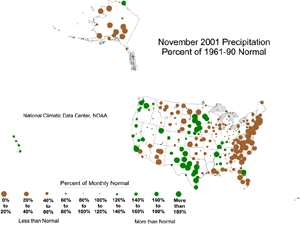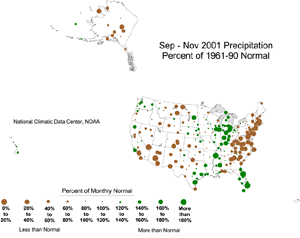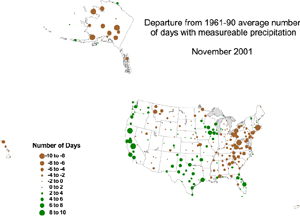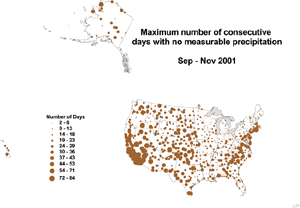U.S. Drought Highlights:
|
Contents Of This Report: |
National Overview
On the national scale,
|
 larger image |
 larger image |
Although some areas of the U.S. had well above normal precipitation, many areas were very dry. November averaged near normal when precipitation is integrated across the nation. Eleven of the last 28 months have averaged well below the normal, while only three averaged well above normal (see graph to right). National 2001 precipitation ranks:
|
 larger image |
Regional Overview
Beneficial rain and snow during October and November brought short-term relief from drought to much of the western U.S., however long-term drought continued to plague much of the region, especially from the interior basin to the Rockies. November was dry across parts of the Southwest, northern Rockies, and northern and central Plains. November marked the second consecutive dry month along the eastern seaboard, intensifying long-term drought conditions. The primary stations in Hawaii were wet during November, but most of the Alaska stations were dry. This overall pattern is evident in the following indicators:
|
 Western U.S. Drought
Western U.S. Drought
| A series of moist Pacific storm systems continued to bring short-term relief from the drought to parts of the western U.S., resulting in the second consecutive month with above-normal precipitation for the Pacific Northwest (see graph below left) and the 18th wettest November for the West region. The 2001-2002 Northwest wet season had a good start as late November-early December snowstorms increased the water content of the snow pack from below average on November 27 to well above-average by December 6. In spite of the 25th wettest October-November, long-term moisture deficits remained with the region having the eleventh driest December-November on record in 2001. The Southwest region had a near-normal November, but the two previous dry months resulted in the 14th driest autumn (September-November) for the region. Highlights: |
|
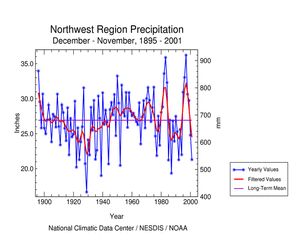 larger image |
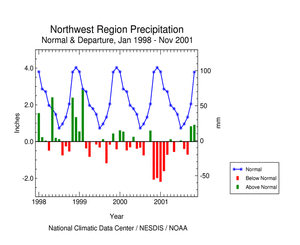 larger image |
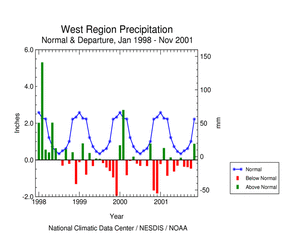 larger image |
 Eastern U.S. Drought
Eastern U.S. Drought
| A dry weather pattern in the eastern U.S. intensified during November and resulted in escalating drought effects, including diminishing reservoir supplies, wildfire activity, and poor winter wheat establishment -- during a period in which symptoms of drought are often masked by cool weather and diminishing agricultural and municipal water requirements. November marked the second consecutive dry month across the eastern seaboard. October-November 2001 ranked as the fourth driest in the 107-year record for the Northeast region and sixth driest for the Southeast. |
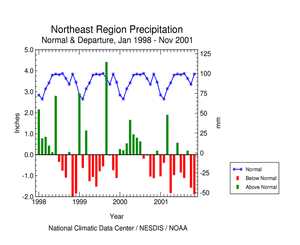 larger image |
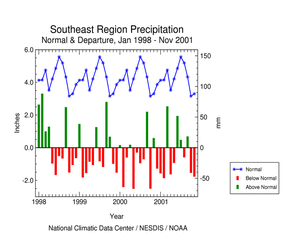 larger image |
The persistent dryness during 2001 in the Northeast region is comparable to the deficits experienced at the height of the major Northeast drought of the 1960's (see table to right). Some highlights:
|
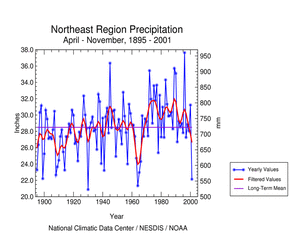 larger image
|
The Southeast has been plagued by both short-term and long-term dryness during 2001. Some highlights:
|
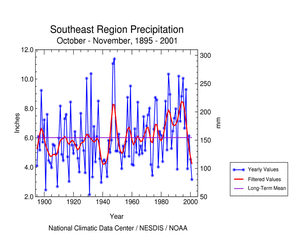 larger image |

 Additional Contacts:
Additional Contacts:
| Damage due to the drought has been summarized by NOAA and the Office of Global Programs in the Climatological Impacts section of the Climate Information Project. Crop impact information can be found at the USDA NASS (National Agricultural Statistics Service) and Weekly Weather and Crop Bulletin pages. Drought statements by local National Weather Service Offices can be found at the NWS Hydrologic Information Center. Drought threat assessments and other information can be found at NOAA's Drought Information Center. Additional drought information can be found at the National Drought Mitigation Center, the USDA's National Agricultural Library, the interim National Drought Council, and the NOAA Paleoclimatology Program. The following states have set up web pages detailing current drought conditions and/or their plans to handle drought emergencies:
For additional information on the 2001 wildfire season please see the National Interagency Fire Center web site or the U.S. Forest Service Fire and Aviation web site. NCDC's Drought Recovery Page shows the precipitation required to end or ameliorate droughts and the probability of receiving the required precipitation. Additional climate monitoring graphics can be found at the Climate Prediction Center's monitoring pages: |
 NOAA's National Centers for Environmental Information
NOAA's National Centers for Environmental Information
